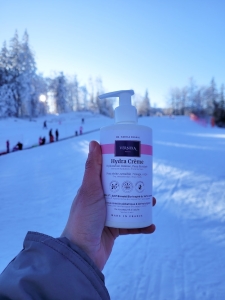Reading Time: mins
🙂 Hello dear parents! If you’re reading this article, it’s probably because you’re concerned about the health of your baby’s skin. Baby eczema is a topic that concerns many parents, and we’re here to provide you with information based on scientific research. So relax and find out how to care for your little treasure’s delicate skin 🙂
Although we rely on scientific and medical sources and have skin care experts on our team, every case and situation is different. Our content is not a substitute for medical advice. We recommend that you consult a healthcare professional if you have any questions or concerns about the health of your baby’s skin.
Eczema, also known as atopic dermatitis (AD), is an inflammatory skin disease that can develop as early as infancy REF [^1^]. It is characterized by outbreaks of itchy, inflammatory skin eruptions. AD is often associated with a reduction in the skin’s barrier function, leading to periodic REF[^2^] rashes.
Atopic skin is skin that tends to be dry and develop rashes, because the cutaneous barrier is altered and no longer plays its protective role. It is therefore extremely fragile.
Atopic dermatitis is the most common form of eczema in children. It is clinically defined and its diagnosis is based on REF-assessed criteria [^1^]. To date, its exact cause remains uncertain.
Common signs of AD in babies include red patches and inflammation of the skin, intense itching and dry, damaged skin. Other signs include rough skin, crusting or oozing from lesions, and recurrent skin infections REF[^2^].
AD is cyclical, alternating between flare-ups and lulls REF [^3^]. During flare-ups, the skin can become very irritated, red and inflamed. These can be triggered by a variety of factors, such as allergens, skin infections or even stress REF [^3^].
Research suggests that AD may have a genetic component. This means that if a parent has had AD, the child may be more likely to develop it REF[^3^]. However, other factors can also trigger or aggravate the disease.
From the very first signs of atopic eczema in babies and children, it’s important to take the necessary steps to prevent complications. It is therefore essential for parents to know how to identify them.
AD plaques can appear anywhere on the body, but are commonly localized on the face, behind the ears, on the hands, wrist and in the folds of the arms or legs in babies and children REF [^1^].
One of the most disturbing symptoms of AD is intense itching. Itching can be so severe that it disrupts the baby’s sleep and quality of life REF [^1^]. Scratching can also lead to superinfection. It is therefore important to relieve baby as soon as possible.
As the skin’s barrier function is impaired, this allows allergens and irritants to penetrate the skin more easily, triggering an inflammatory response REF[^2^]. This barrier function depends on the quality of both the stratum corneum and the hydrolipidic film on the skin’s surface.
The exact cause of AD is unknown, but it is probably multifactorial. Genetic, environmental and immunological factors may all play a role in its development REF [^3^]. Other factors such as allergens, infections and even stress can also trigger or aggravate REF disease [^2^].
The environment plays a key role in the development and aggravation of AD. Allergens such as dust mites, pollen and food can trigger flare-ups in some individuals with atopy-prone skin REF [^3^].
Infant eczema is a form of AD that generally appears before the age of 2. It is characterized by red, itchy rashes, usually on the face and scalp REF [^1^].
Recognizing infant eczema is the first step to providing relief. Understanding triggers and avoiding irritants can help relieve REF symptoms [^2^].
Contact eczema, unlike atopic eczema, is caused by direct contact with an irritant or allergen. It usually manifests as a red, itchy rash at the site of contact REF [^2^].
Although eczema cannot be cured, it can be managed with appropriate treatment. Moisturizers, topical corticosteroids and calcineurin inhibitors are commonly used to treat REF eczema [^1^].
If your baby presents the various symptoms of AD, it is recommended to consult a health professional for a proper diagnosis REF [^2^].
The duration of AD flare-ups varies from person to person. With appropriate treatment, it is possible to manage these flare-ups and prolong periods of calm REF [^1^].
Although AD cannot be cured, some natural remedies, such as oatmeal baths and the application of emollients like natural oils, can help relieve REF[^4^] symptoms.
🌿 Why choose Vernixa® for your baby’s skin care? At Vernixa®, we understand the importance of caring for your baby’s delicate skin. Our products, such as Vernixa® Hydra Crème, are formulated with high-quality ingredients such as Lipidic V®, inspired by vernix caseosa, to provide intense hydration and long-lasting protection against external aggressors. Our products act like a shield to preserve the skin barrier and prevent the onset of skin problems.
Developed under the direction of Dr. Nabila Belhaj, Vernixa® Hydra Crème is the fruit of over 17 years of scientific research into lipids. It is rich, non-greasy and quickly absorbed, leaving skin soft and moisturized. Tested under pediatric and dermatological control, it is suitable for newborns, babies, children and adults, offering a complete solution for the whole family.
Taking care of your baby’s skin is essential to prevent and manage atopic dermatitis. With the right information and the right products, you can help your baby have healthy, happy skin. Thank you for trusting us to provide you with information based on scientific research. Take care of yourself and your little treasure 🙂
Although we rely on scientific and medical sources and have skin care experts on our team, every case and situation is different. Our content is not a substitute for medical advice. We recommend that you consult a healthcare professional if you have any questions or concerns about the health of your baby’s skin.
All Rights Reserved | Tous Droits Réservés GTIN Compliance Hydra Lavant | GTIN Compliance Hydra Crème



